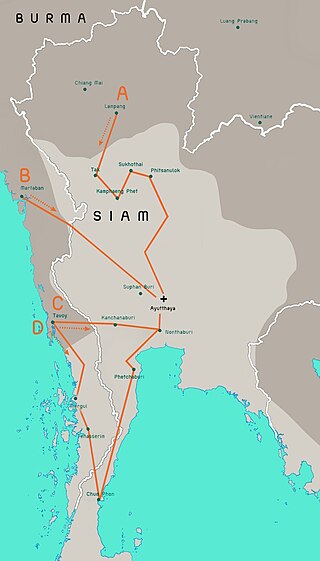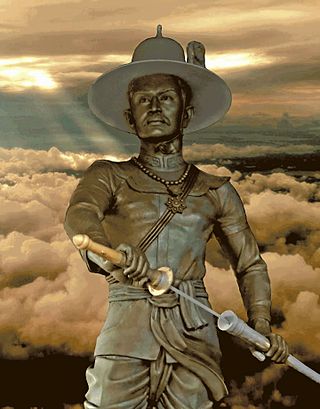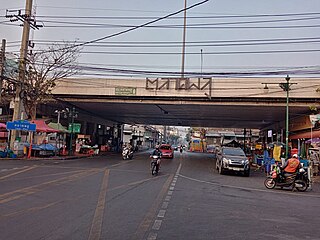Siam is the former name of Thailand, and is used to refer to the historical region of Central Thailand, usually including Southern Thailand.
Contents
Siam or SIAM may also refer to:
Siam is the former name of Thailand, and is used to refer to the historical region of Central Thailand, usually including Southern Thailand.
Siam or SIAM may also refer to:

Bangkok, officially known in Thai as Krung Thep Maha Nakhon and colloquially as Krung Thep, is the capital and most populous city of Thailand. The city occupies 1,568.7 square kilometres (605.7 sq mi) in the Chao Phraya River delta in central Thailand and has an estimated population of 9.0 million as of 2021, 13% of the country's population. Over 17.4 million people (25%) lived within the surrounding Bangkok Metropolitan Region at the 2021 estimate, making Bangkok an extreme primate city, dwarfing Thailand's other urban centres in both size and importance to the national economy.

Phra Bat Somdet Phra Phutthayotfa Chulalok Maharat, personal name Thongduang (ทองด้วง), also known as Rama I, was the founder of the Rattanakosin Kingdom and the first King of Siam from the reigning Chakri dynasty. His full title in Thai is Phra Bat Somdet Phra Paramoruracha Maha Chakri Boromanat Phra Phutthayotfa Chulalok. He ascended the throne in 1782, following the deposition of King Taksin of Thonburi. He was also celebrated as the founder of Rattanakosin as the new capital of the reunited kingdom.

Thonburi is an area of modern Bangkok. During the era of the Kingdom of Ayutthaya, its location on the right (west) bank at the mouth of the Chao Phraya River had made it an important garrison town, which is reflected in its name: thon (ธน) a loanword from Pali dhána 'wealth', and buri (บุรี), from púra, 'fortress'. The full formal name was Thon Buri Si Mahasamut. For the informal name, see the history of Bangkok under Ayutthaya.
Kingdom of Siam may refer to:

The Thonburi Kingdom was a major Siamese kingdom which existed in Southeast Asia from 1767 to 1782, centered around the city of Thonburi, in Siam or present-day Thailand. The kingdom was founded by Taksin the Great, who reunited Siam following the collapse of the Ayutthaya Kingdom, which saw the country separate into five warring regional states. The Thonburi Kingdom oversaw the rapid reunification and reestablishment of Siam as a preeminient military power within mainland Southeast Asia, overseeing the country's expansion to its greatest territorial extent up to that point in its history, incorporating Lan Na, the Laotian kingdoms, and Cambodia under the Siamese sphere of influence.
The history of Bangkok, the capital of Thailand, dates at least to the early 15th century, when it was under the rule of Ayutthaya. Due to its strategic location near the mouth of the Chao Phraya River, the town gradually increased in importance, and after the fall of Ayutthaya King Taksin established his new capital of Thonburi there, on the river's west bank. King Phutthayotfa Chulalok, who succeeded Taksin, moved the capital to the eastern bank in 1782, to which the city dates its foundation under its current Thai name, "Krung Thep Maha Nakhon". Bangkok has since undergone tremendous changes, growing rapidly, especially in the second half of the 20th century, to become the primate city of Thailand. It was the centre of Siam's modernization in the late 19th century, subjected to Allied bombing during the Second World War, and has long been the modern nation's central political stage, with numerous uprisings and coups d'état having taken place on its streets throughout the years.

Wongwian Yai, also spelled "Wong Wian Yai" or "Wongwien Yai", is a large roundabout in Thonburi, on the west bank of the Chao Phraya River in Bangkok, Thailand, where the statue of King Taksin is situated.

The Burmese–Siamese War of 1765–1767, also known as the war of the second fall of Ayutthaya was the second military conflict between Burma under the Konbaung dynasty and Ayutthaya Kingdom under the Siamese Ban Phlu Luang dynasty that lasted from 1765 until 1767, and the war that ended the 417-year-old Ayutthaya Kingdom.

Thonburi Palace, also known in Thai as Phra Racha Wang Derm, is the former royal palace of King Taksin, who ruled the Siamese (Thai) kingdom of Thonburi following the fall of Ayutthaya in 1767 and up until the establishment of Rattanakosin in 1782. It later served as the residence of several high-ranking members of the Chakri dynasty until 1900 when the palace became the site of the Royal Thai Naval Academy. The palace is now within the grounds of the Royal Thai Navy headquarters in Bangkok, and is open for group visits pending advance appointment.

Bangkok's Chinatown is one of the largest Chinatowns in the world. It was founded in 1782 when the city was established as the capital of the Rattanakosin Kingdom, and served as the home of the mainly Teochew immigrant Chinese population, who soon became the city's dominant ethnic group. Originally centred around Sampheng, the core of Chinatown now lies along Yaowarat Road, which serves as its main artery and sometimes lends its name to the entire area, which is often referred to as Yaowarat. Chinatown's entire area roughly coincides with Samphanthawong District, and includes neighbourhoods such as Song Wat and Talat Noi along the Chao Phraya River, and Charoen Chai, Khlong Thom and Nakhon Khasem along Charoen Krung Road.

The Burmese–Siamese War (1775–1776) or Maha Thiha Thura's Invasion of Siam or Athi Wungyi's War was a major military conflict between the Konbaung dynasty of Burma and the Thonburi Kingdom of Siam.

King Taksin the Great or the King of Thonburi was the only king of the Thonburi Kingdom that ruled Thailand from 1767 to 1782. He had been an aristocrat in the Ayutthaya Kingdom and then was a major leader during the liberation of Siam from Burmese occupation after the Second Fall of Ayutthaya in 1767, and the subsequent unification of Siam after it fell under various warlords. He established the city of Thonburi as the new capital, as the city of Ayutthaya had been almost completely destroyed by the invaders. His reign was characterized by numerous wars; he fought to repel new Burmese invasions and to subjugate the northern Thai kingdom of Lanna, the Laotian principalities, and threatening Cambodia.

Talat Phlu or Talad Phlu is a community and marketplace by the canal Khlong Bangkok Yai in Talat Phlu subdistrict, Thon Buri district, Thonburi side of Bangkok.
The Thai nobility was a social class comprising titled officials in the service of the monarchy. They formed part of a hierarchical social system which developed from the time of the Ayutthaya Kingdom, through the Thonburi (1767–1782) and early Rattanakosin periods. Reforms by King Chulalongkorn ended the system around the end of the 19th century, though noble titles continued to be granted until the abolition of absolute monarchy in 1932.
Phraya Rachasetthi, personal name Chen Lian or Tang Lieng or Trần Liên was the governor of Hà Tiên from 1771 to 1773, appointed by King Taksin of Thonburi. He was a Teochew Chinese general of the Thonburi Kingdom, formerly known as Luang Phiphit (หลวงพิพิธ) and Phraya Phiphit (พระยาพิพิธ). He was also known colloquially as Chao Khrua Lian (เจ้าขรัวเหลียน) or Chiêu Khoa Liên (昭科聯) and as Phraya Rachasethi Chin.

Ban Bu Community is a traditional community in the Siri Rat Subdistrict, Bangkok Noi District, Bangkok's Thonburi side. It is regarded as the last source of bronzework handicraft makers in Bangkok and has become a cultural tourism destination.

Following the Sack of Ayutthaya and the collapse of the Ayutthaya Kingdom (1351–1767) during the Burmese–Siamese War (1765–1767), a power vacuum left Siam divided into 5 separate states—Phimai, Phitsanulok, Sawangburi, Nakhon Si Thammarat, and Thonburi. The Burmese invasion force, having returned to Burma off their successful sack of Ayutthaya and to defend its homeland against an imposing Chinese invasion of Ava, were too preoccupied to take advantage of the power vacuum in Siam.

Lao–Siamese War or the Siamese Invasion of Laos (1778–1779) is the military conflict between Thonburi Kingdom of Siam and the Lao kingdoms of Vientiane and Champasak. The war resulted in all three Lao kingdoms of Luang Phrabang, Vientiane and Champasak becoming Siamese tributary vassal kingdoms under Siamese suzerainty and domination in Thonburi and the subsequent Rattanakosin Period.
Phra Chao Khattiya Ratchanikhom, or Chaophraya Nakhon Si Thammarat, personal name Nu, was the leader of the Nakhon Si Thammarat (Ligor) regime of Southern Siam after the Fall of Ayutthaya in 1767 until his subjugation by King Taksin in 1769. Also known as Chao Nakhon or Phra Palat Nu, he became an autonomous ruler of Nakhon Si Thammarat again from 1777 to 1784 under the Thonburi kingdom.

The Thonburi city moat is the collective name of many several waterways in the form of moats on the Thonburi side or the west bank of the Chao Phraya river, location of Thonburi Kingdom, the former capital of Thailand between the years 1767 to 1782 ruled by a single monarch, King Taksin.